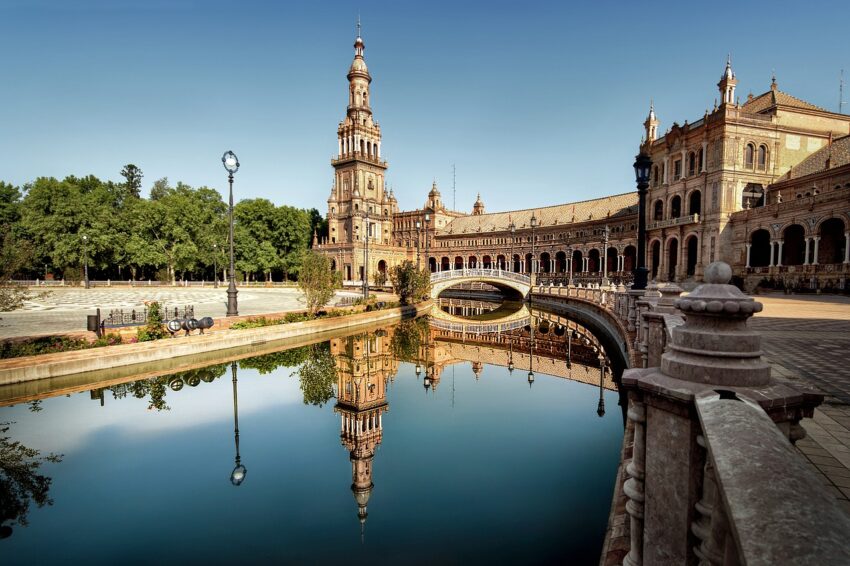Travel
Visa Free Travel Surge, Spain Over Tourism News, Chinese Tourists’ Tsunami, and APAC’s Rise as a Tourism Powerhouse Mark a Major Shifts in Global Industry Trends in August – Travel And Tour World

Thursday, August 1, 2024
Reading Time: 11 minutes
August marks significant shifts in global tourism trends, with visa-free travel surges boosting tourism in various regions. Spain faces alarming over tourism challenges as it struggles to manage the influx of visitors. Meanwhile, the “tsunami” of Chinese tourists continues to reshape global travel dynamics, bringing both opportunities and challenges for popular destinations. Additionally, the Asia-Pacific (APAC) region is emerging as a tourism powerhouse, driven by rising disposable incomes and increased travel activity. These developments highlight the evolving landscape of global tourism, emphasizing the need for sustainable practices and strategic planning to balance growth and preservation.
August is a pivotal month for tourism across the Asia-Pacific region. As the summer holiday season peaks, many countries in this dynamic and culturally rich part of the world experience a significant influx of tourists.
Several factors contribute to this surge, including school holidays, favorable weather conditions, and major cultural festivals. Additionally, countries like the Maldives, Jordan, Singapore, Indonesia, Malaysia, Thailand and APAC Region are actively working to boost their tourism and travel industries, often looking towards the burgeoning Indian market. However, while the potential for growth is substantial, there are challenges to be mindful of, particularly concerning airline outages which can disrupt travel plans and impact the tourism sector.

APAC Projected to Reign as Global Tourism Leader by 2026
The Asia-Pacific (APAC) region is set to become the king of global tourism by 2026, driven by rising disposable incomes and a burgeoning middle class. This economic shift means that more people across the region have the financial capacity to travel, both domestically and internationally, positioning APAC as an increasingly attractive destination for global tourists.
Economic Growth Fuels Travel Boom
The APAC region has experienced significant economic growth over the past decade, with countries like China, India, and Southeast Asian nations leading the charge. This growth has resulted in a substantial increase in disposable incomes, enabling more people to afford travel and leisure activities. According to recent forecasts, the number of middle-class consumers in APAC is expected to double by 2030, reaching 3.5 billion. This expanding middle class is eager to explore new destinations and experiences, both within their own region and abroad.
Diverse Attractions and Cultural Richness
APAC’s diverse attractions are a major draw for tourists. From the bustling cities of Tokyo, Bangkok, and Singapore to the serene beaches of Bali and the cultural heritage sites of India and Cambodia, the region offers something for every type of traveler. Additionally, APAC’s rich cultural diversity, history, and traditions provide unique and enriching experiences that appeal to tourists seeking both adventure and cultural immersion.
Investment in Infrastructure
Governments across the APAC region are investing heavily in tourism infrastructure to support the anticipated influx of travelers. This includes expanding airports, improving public transportation, and developing new tourist attractions. For example, China’s Belt and Road Initiative includes significant investments in infrastructure projects that enhance connectivity and accessibility, facilitating easier and more efficient travel within the region.
Technological Advancements and Innovation
APAC is also at the forefront of technological advancements in the travel industry. From state-of-the-art booking platforms and mobile applications to smart tourism initiatives that leverage artificial intelligence and data analytics, the region is embracing innovation to enhance the travel experience. These advancements not only make travel more convenient and enjoyable for tourists but also help destinations manage tourism sustainably by analyzing visitor patterns and optimizing resources.
The Rise of Intra-Regional Travel
In addition to attracting international tourists, APAC is witnessing a surge in intra-regional travel. As disposable incomes rise, more people are exploring neighboring countries, contributing to the region’s tourism boom. Initiatives like the ASEAN single visa proposal aim to facilitate seamless travel across Southeast Asia, further boosting tourism within the region.
Sustainability and Responsible Tourism
As APAC prepares for a tourism surge, there is a growing emphasis on sustainability and responsible tourism. Destinations are increasingly focusing on preserving their natural and cultural heritage while promoting eco-friendly practices. Efforts to manage overtourism, protect the environment, and support local communities are becoming integral to tourism strategies across the region.

Chinese Tourists’ Arrivals to Visa-Free Nations Boost Tourism
The rise in Chinese tourists traveling to visa-free nations has significantly boosted tourism industries around the globe. As the middle class in China continues to grow, more citizens are looking to explore international destinations, and visa-free access plays a crucial role in their travel decisions.
The Appeal of Visa-Free Travel
Visa-free travel simplifies the process for Chinese tourists, eliminating the need for time-consuming and often costly visa applications. This ease of access encourages more spontaneous travel, leading to a surge in last-minute bookings and extended stays. Countries offering visa-free entry or visa-on-arrival for Chinese tourists have seen a notable increase in visitor numbers, directly benefiting their tourism sectors.
Popular Visa-Free Destinations
Several countries have emerged as top choices for Chinese tourists due to their visa-free policies. Southeast Asian nations like Thailand, Indonesia, and Malaysia, as well as popular destinations like the Maldives, have experienced significant increases in Chinese tourist arrivals. These destinations offer a mix of cultural experiences, natural beauty, and luxury accommodations, all accessible without the hassle of obtaining a visa.

Thailand
Thailand remains a perennial favorite for Chinese tourists, with its rich cultural heritage, stunning beaches, and vibrant nightlife. The ease of travel, coupled with a wide range of shopping and dining options, makes Thailand an attractive destination for Chinese travelers. According to recent statistics, Chinese visitors account for a substantial portion of Thailand’s total international arrivals, contributing significantly to the local economy.
Maldives
The Maldives, renowned for its luxury resorts and breathtaking marine life, has also benefited from visa-free access for Chinese tourists. The country’s tourism board has actively promoted the Maldives in China, resulting in a steady flow of visitors. Chinese tourists are particularly drawn to the Maldives’ unique experiences, such as underwater dining and overwater villas, which offer unparalleled luxury and exclusivity.
Economic Impact
The influx of Chinese tourists to visa-free nations has had a positive economic impact. Increased visitor numbers translate to higher spending on accommodation, dining, shopping, and recreational activities. This boost in tourism revenue supports local businesses, creates jobs, and contributes to overall economic growth. For many countries, Chinese tourists represent a significant and growing market, driving efforts to further ease travel restrictions and enhance the visitor experience.
Challenges and Considerations
While the surge in Chinese tourists is largely beneficial, it also presents challenges. Managing increased visitor numbers requires adequate infrastructure, including transportation, accommodation, and tourist services. Countries must balance the economic benefits of tourism with the need to preserve cultural heritage and natural environments. Sustainable tourism practices are essential to ensure long-term viability and minimize negative impacts on local communities and ecosystems.

Spain’s Overtourism is Alarming
Spain, one of the world’s most popular tourist destinations, is facing a growing crisis of overtourism. With its rich history, vibrant culture, and picturesque landscapes, Spain attracts millions of visitors each year. However, the sheer volume of tourists is putting immense pressure on the country’s infrastructure, environment, and local communities.
The Scale of Overtourism
Spain’s most iconic destinations, such as Barcelona, Madrid, and the Balearic Islands, are particularly affected by overtourism. In cities like Barcelona, the influx of tourists has led to overcrowded streets, congested public transportation, and a strain on local resources. Popular attractions, such as the Sagrada Familia and Park Güell, are often overwhelmed by visitors, detracting from the experience and leading to concerns about the preservation of these sites.
Economic and Social Impact
While tourism is a vital part of Spain’s economy, contributing significantly to GDP and employment, the negative consequences of overtourism are becoming increasingly apparent. Local residents in heavily touristed areas often face rising living costs, housing shortages, and disruptions to their daily lives. The influx of tourists can lead to the displacement of local businesses, with shops and services catering more to visitors than residents.
Environmental Concerns
The environmental impact of over tourism is also alarming. Popular beach destinations suffer from pollution, and natural habitats are threatened by the constant influx of visitors. The Balearic Islands, for instance, face challenges related to waste management and water consumption, which are exacerbated by the high number of tourists.
Addressing Over tourism
To mitigate the effects of overtourism, Spain is implementing several measures. These include promoting lesser-known destinations, investing in sustainable tourism practices, and regulating short-term rentals. By encouraging tourists to explore off-the-beaten-path locations, Spain hopes to distribute the economic benefits of tourism more evenly and reduce pressure on overcrowded hotspots.
Sustainable Tourism Initiatives
Spain is also focusing on sustainable tourism initiatives to preserve its cultural and natural heritage. Efforts are being made to limit the number of visitors to sensitive sites, improve waste management, and promote eco-friendly travel options. Public awareness campaigns aim to educate tourists about responsible travel practices and the importance of respecting local communities and environments.

Maldives Seeks Tourism Boost from India
The Maldives, with its pristine beaches and luxurious resorts, continues to be a top destination for Indian travelers. The archipelago has implemented several strategies to attract more tourists from India, recognizing the country’s vast potential as a source market.
Targeted Marketing and Promotions
The Maldives Marketing and Public Relations Corporation (MMPRC) has launched targeted marketing campaigns in India. These campaigns highlight the unique experiences the Maldives offers, such as underwater dining, overwater villas, and world-class diving spots. Collaborations with Indian travel agencies and influencers further amplify these efforts, reaching a broader audience.
Enhanced Connectivity
Direct flight connections between major Indian cities and Maldivian destinations have been increased. Airlines like Air India, IndiGo, and GoAir offer frequent flights to the Maldives, making it a convenient getaway for Indian tourists. The increased connectivity not only reduces travel time but also makes the Maldives a more accessible and attractive option for short vacations.
Tailored Experiences
To cater to Indian tourists, many Maldivian resorts and hotels have tailored their offerings. This includes providing Indian cuisine, employing Hindi-speaking staff, and creating packages that appeal to Indian families and honeymooners. Special events, such as Bollywood-themed parties and Indian festivals, are also organized to make Indian tourists feel more at home.

Jordan Looks to the Indian Market
Jordan, rich in historical and cultural heritage, is also focusing on attracting tourists from India. The Kingdom of Jordan sees great potential in the Indian market due to the growing middle class and increasing number of Indians traveling abroad.
Strategic Partnerships
The Jordan Tourism Board (JTB) has formed strategic partnerships with Indian travel agents and tour operators. These partnerships are crucial for creating customized tour packages that appeal to Indian tourists, including visits to iconic sites like Petra, the Dead Sea, and Wadi Rum.
Visa Facilitation
To simplify the travel process, Jordan has introduced a visa-on-arrival facility for Indian nationals. This move significantly reduces the hassle of pre-trip visa applications, encouraging more spontaneous travel decisions.
Cultural Promotions
Jordan is promoting its cultural ties with India by participating in Indian travel trade shows and hosting cultural exchange programs. These initiatives aim to educate Indian travelers about Jordan’s rich history and diverse experiences, from ancient ruins to modern attractions.

Singapore, Indonesia, Malaysia, and Thailand Boost Tourism and Travel Industry
Southeast Asia remains a hotspot for tourism, with countries like Singapore, Indonesia, Malaysia, and Thailand continually enhancing their tourism strategies to attract more visitors.
Singapore: A Hub of Modern Attractions
Singapore is renowned for its clean streets, safety, and plethora of attractions. The Singapore Tourism Board (STB) has been proactive in its marketing efforts, promoting the city-state’s diverse offerings.
- Attractions and Events: Singapore boasts a range of attractions, including Sentosa Island, Gardens by the Bay, and Universal Studios. Events like the Singapore Grand Prix and various cultural festivals also draw large crowds.
- Health and Safety: With the ongoing global health concerns, Singapore has emphasized its rigorous health and safety measures, reassuring travelers of a safe visit.
- Shopping and Dining: Singapore is a shopper’s paradise, with a wide array of retail options ranging from luxury brands to local markets. The city also offers a rich culinary scene that caters to all tastes.
Indonesia: Paradise for Nature and Culture Lovers
Indonesia, with its vast archipelago, offers a variety of experiences from vibrant city life in Jakarta to serene beaches in Bali and the cultural heartland of Yogyakarta.
- Eco-Tourism: Indonesia is promoting eco-tourism, emphasizing sustainable travel practices that protect its natural beauty. Destinations like Bali, Komodo Island, and Raja Ampat are particularly popular among nature enthusiasts.
- Cultural Heritage: The Indonesian government is investing in preserving and promoting its cultural heritage. Festivals, traditional crafts, and historical sites are key attractions for tourists.
- Adventure Tourism: Indonesia offers numerous adventure activities, including surfing, diving, and trekking. The country’s diverse landscapes provide the perfect backdrop for these activities.
Malaysia: A Blend of Modernity and Tradition
Malaysia is known for its rich cultural heritage, modern cities, and natural beauty. The country is working to position itself as a leading tourist destination in the region.
- Cultural Diversity: Malaysia’s multicultural society is a major draw for tourists. The country celebrates a variety of festivals, and its diverse culinary scene reflects its cultural richness.
- Nature and Wildlife: Malaysia’s national parks, beaches, and islands offer tourists a chance to explore its natural beauty. The country is home to several UNESCO World Heritage Sites, including the Gunung Mulu National Park and Kinabalu Park.
- Medical Tourism: Malaysia is also emerging as a hub for medical tourism, offering high-quality healthcare services at competitive prices. This has attracted tourists looking for medical treatments combined with a holiday experience.
Thailand: The Land of Smiles
Thailand remains a favorite among tourists for its hospitality, diverse attractions, and vibrant culture.
- Popular Destinations: Bangkok, Phuket, and Chiang Mai are among the top destinations in Thailand. The country offers a mix of bustling city life, tranquil beaches, and cultural experiences.
- Wellness Tourism: Thailand is renowned for its wellness tourism, offering everything from luxury spas to traditional Thai massages. The country’s wellness retreats attract tourists looking to rejuvenate their minds and bodies.
- Adventure and Nature: Thailand offers a range of adventure activities, including scuba diving, rock climbing, and jungle trekking. Its national parks and marine reserves are popular among nature lovers.
The Need to Be Alert on Airline Outages
While the potential for tourism growth in the Asia-Pacific region is substantial, it is crucial to remain vigilant about airline outages. These disruptions can have significant impacts on the travel industry, affecting both the tourism sector and travelers’ experiences.
Causes of Airline Outages
Airline outages can occur due to various reasons, including technical glitches, natural disasters, and operational issues. Understanding these causes can help in mitigating the impact and preparing for potential disruptions.
- Technical Issues: Technical failures in airline systems can lead to widespread outages. These can include failures in reservation systems, check-in systems, and other critical operations.
- Natural Disasters: Natural disasters such as typhoons, earthquakes, and volcanic eruptions can disrupt flight schedules and operations. These events are particularly relevant in the Asia-Pacific region, which is prone to such occurrences.
- Operational Challenges: Airline strikes, staffing shortages, and logistical challenges can also lead to outages. These operational issues can affect the smooth functioning of airline services.
Impact on Tourism
Airline outages can have a ripple effect on the tourism industry, leading to financial losses, reputational damage, and logistical challenges.
- Financial Losses: Flight cancellations and delays can result in significant financial losses for airlines, travel agencies, and tourists. These disruptions can also affect the revenue of hotels, restaurants, and other tourism-related businesses.
- Reputational Damage: Frequent airline outages can damage the reputation of airlines and the destinations they serve. Travelers may be hesitant to visit regions with a history of frequent disruptions.
- Logistical Challenges: Managing large-scale disruptions can be challenging for airlines and airports. Coordinating with passengers, providing alternative travel arrangements, and handling refunds can be complex and time-consuming.
Mitigation Strategies
To minimize the impact of airline outages, several mitigation strategies can be implemented.
- Enhanced Communication: Effective communication with passengers is crucial during outages. Airlines should provide timely updates and clear information about alternative arrangements.
- Robust Systems: Investing in robust and reliable airline systems can reduce the risk of technical failures. Regular maintenance and updates of these systems are essential.
- Disaster Preparedness: Airlines and airports should have comprehensive disaster preparedness plans in place. This includes contingency plans for natural disasters and other emergencies.
- Collaboration: Collaboration between airlines, airports, and tourism authorities can help in managing disruptions more effectively. Joint efforts can ensure a coordinated response to outages.
August is indeed a prime month for tourism in the Asia-Pacific region, with countries like the Maldives, Jordan, Singapore, Indonesia, Malaysia, and Thailand actively working to attract more visitors. By focusing on targeted marketing, enhanced connectivity, and tailored experiences, these destinations are well-positioned to capitalize on the growing demand for travel. However, the potential for growth must be balanced with the need to address challenges such as airline outages. By implementing effective mitigation strategies, the tourism industry can continue to thrive and provide memorable experiences for travelers from around the world.






/cdn.vox-cdn.com/uploads/chorus_asset/file/25626295/247263_iphone_16_pro_AKrales_0799.jpg)


